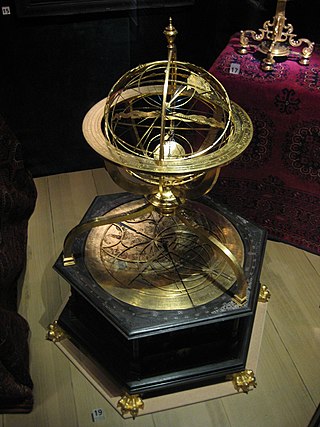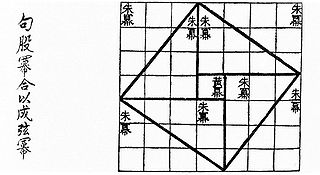
Flat Earth is an archaic and scientifically disproven conception of the Earth's shape as a plane or disk. Many ancient cultures subscribed to a flat-Earth cosmography, notably including the cosmology in the ancient Near East. The model has undergone a recent resurgence as a conspiracy theory.

An armillary sphere is a model of objects in the sky, consisting of a spherical framework of rings, centered on Earth or the Sun, that represent lines of celestial longitude and latitude and other astronomically important features, such as the ecliptic. As such, it differs from a celestial globe, which is a smooth sphere whose principal purpose is to map the constellations. It was invented separately, in ancient China possibly as early as the 4th century BC and ancient Greece during the 3rd century BC, with later uses in the Islamic world and Medieval Europe.

Herbert Allen Giles was a British diplomat and sinologist who was the professor of Chinese at the University of Cambridge for 35 years. Giles was educated at Charterhouse School before becoming a British diplomat in China. He modified a Mandarin Chinese romanization system established by Thomas Wade, resulting in the widely known Wade–Giles Chinese romanization system. Among his many works were translations of the Analects of Confucius, the Lao Tzu , the Chuang Tzu, and, in 1892, the widely published A Chinese–English Dictionary.

Noel Joseph Terence Montgomery Needham was a British biochemist, historian of science and sinologist known for his scientific research and writing on the history of Chinese science and technology, initiating publication of the multivolume Science and Civilisation in China. A focus of his was what has come to be called the Needham Question of why and how China had ceded its leadership in science and technology to Western countries.

The Needham Research Institute, located on the grounds of Robinson College, in Cambridge, England, is a centre for research into the history of science, technology and medicine in East Asia. The institute is named after the biochemist and historian Joseph Needham, who initiated the Science and Civilisation in China series. The current director is Mei Jianjun, a noted archaeo-metallurgist.
Liu Xin, courtesy name Zijun, was a Chinese astronomer, classicist, imperial librarian, mathematician, and politician during the Western Han and Xin dynasties. He later changed his name to Liu Xiu (劉秀) due to the naming taboo of Emperor Ai of Han. He was the son of Imperial librarian Liu Xiang and an associate of other eminent thinkers such as the philosopher Huan Tan. Liu was a prominent supporter of the Old Text classics.

Li Fan was a Chinese astronomer during the Han dynasty.

The Bencao gangmu, known in English as the Compendium of Materia Medica or Great Pharmacopoeia, is an encyclopedic gathering of medicine, natural history, and Chinese herbology compiled and edited by Li Shizhen and published in the late 16th century, during the Ming dynasty. Its first draft was completed in 1578 and printed in Nanjing in 1596. The Compendium lists the materia medica of traditional Chinese medicine known at the time, including plants, animals, and minerals that were believed to have medicinal properties.

Astronomy in China has a long history stretching from the Shang dynasty, being refined over a period of more than 3,000 years. The ancient Chinese people have identified stars from 1300 BCE, as Chinese star names later categorized in the twenty-eight mansions have been found on oracle bones unearthed at Anyang, dating back to the mid-Shang dynasty. The core of the "mansion" system also took shape around this period, by the time of King Wu Ding.

Mathematics emerged independently in China by the 11th century BCE. The Chinese independently developed a real number system that includes significantly large and negative numbers, more than one numeral system, algebra, geometry, number theory and trigonometry.
Science in the ancient world encompasses the earliest history of science from the protoscience of prehistory and ancient history to late antiquity. In ancient times, culture and knowledge were passed through oral tradition. The development of writing further enabled the preservation of knowledge and culture, allowing information to spread accurately.

The Zhoubi Suanjing, also known by many other names, is an ancient Chinese astronomical and mathematical work. The Zhoubi is most famous for its presentation of Chinese cosmology and a form of the Pythagorean theorem. It claims to present 246 problems worked out by the Duke of Zhou as well as members of his court, placing its composition during the 11th century BC. However, the present form of the book does not seem to be earlier than the Eastern Han (25–220 AD), with some additions and commentaries continuing to be added for several more centuries.
The Book on Numbers and Computation, or the Writings on Reckoning, is one of the earliest known Chinese mathematical treatises. It was written during the early Western Han dynasty, sometime between 202 BC and 186 BC. It was preserved among the Zhangjiashan Han bamboo texts and contains similar mathematical problems and principles found in the later Eastern Han period text of The Nine Chapters on the Mathematical Art.

Ancient Chinese scientists and engineers made significant scientific innovations, findings and technological advances across various scientific disciplines including the natural sciences, engineering, medicine, military technology, mathematics, geology and astronomy.
Nathan Sivin, also known as Xiwen, was an American sinologist, historian, essayist, educator, and writer. He taught first at Massachusetts Institute of Technology, then at the University of Pennsylvania until his retirement in 2006.

Science and Civilisation in China (1954–present) is an ongoing series of books about the history of science and technology in China published by Cambridge University Press. It was initiated and edited by British historian Joseph Needham (1900–1995). Needham was a well-respected scientist before undertaking this encyclopedia and was even responsible for the "S" in UNESCO. To date there have been seven volumes in twenty-seven books. The series was on the Modern Library Board's 100 Best Nonfiction books of the 20th century. Needham's work was the first of its kind to praise Chinese scientific contributions and provide their history and connection to global knowledge in contrast to eurocentric historiography.
Li Ye, born Li Zhi, courtesy name Li Jingzhai, was a Chinese mathematician, politician, and writer who published and improved the tian yuan shu method for solving polynomial equations of one variable. Along with the 4th-century Chinese astronomer Yu Xi, Li Ye proposed the idea of a spherical Earth instead of a flat one before the advances of European science in the 17th century.
Mei Jianjun (梅建军) is an archaeo-metallurgist. As of January 2014, he became Director of the Needham Research Institute, as well as a Fellow of Churchill College, Cambridge University. He served as President of the International Society for the History of East Asian Science, Technology and Medicine (ISHEASTM) in 2015. His book Copper and bronze metallurgy in late prehistoric Xinjiang (2001) presented "significant new archaeological data" relating to the introduction and use of copper and bronze in Xinjiang province and neighboring areas.
Yu Xi, courtesy name Zhongning (仲寧), was a Chinese astronomer, politician, and writer of the Jin dynasty. He is best known for his discovery of the precession of the equinoxes, independently of the earlier ancient Greek astronomer Hipparchus. He also postulated that the Earth could be spherical in shape instead of being flat and square, long before the idea became widely accepted in Chinese science with the advances in circumnavigation by Europeans from the 16th-20th centuries, especially with their arrival into the capital's imperial court in the 17th century.
This is a bibliography of water clocks.










